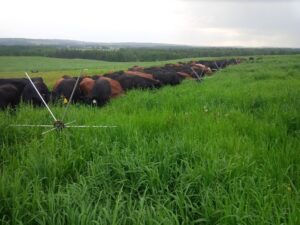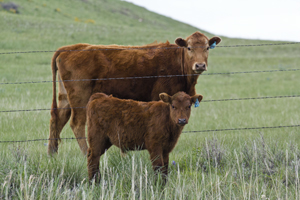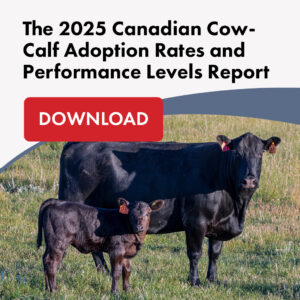Ce que les éleveurs vache-veau canadiens adoptent (et n'adoptent pas) 🎙️
CLIQUEZ SUR LE BOUTON « PLAY » POUR ÉCOUTER CET ÉPISODE (article offert en anglais seulement):
Écoutez d’autres épisodes sur BeefResearch.ca, Spotify, Apple Podcasts, Amazon Music ou Podbean.
Réflexions pour la recherche stratégique et la programmation de la vulgarisation
Une mise à jour complète sur les tendances en matière de pratiques de gestion et de performance dans les exploitations vache-veau canadiennes est désormais disponible auprès du Conseil de recherche sur les bovins de boucherie.
S’appuyant sur plusieurs sources—y compris l’Enquête canadienne vache-veau 2022-2023 menée auprès de 600 répondants à l’échelle nationale, ainsi que les données du Recensement de l’agriculture et de nombreuses autres études universitaires—ce rapport suit les tendances en matière d’adoption de 31 pratiques dans les domaines de la gestion de la reproduction, de la santé des veaux, de la gestion des troupeaux, de l’utilisation du fourrage, de l’intendance environnementale et de la tenue de registres.
Le contrôle de gestation affiche une tendance stable dans l’ensemble du Canada. Dans l’Ouest canadien, sept producteurs sur dix contrôlent la gestation de leurs génisses, et environ les deux tiers des producteurs contrôlent celle de leurs vaches. Dans l’Est du Canada, les taux de contrôle de gestation sont également restés relativement stables, un peu plus de la moitié des producteurs contrôlant à la fois leurs vaches et leurs génisses.
Le rapport montre que la grande majorité (94 %) des répondants vaccinent au moins une catégorie de bovins contre au moins une maladie. Par province, les valeurs indiquent généralement des taux de vaccination plus élevés par rapport aux résultats de l’enquête de 2017.
Partout au Canada, les poids au sevrage ont diminué par rapport à ceux indiqués dans le Rapport sur les taux d’adoption de 2019. Idéalement, le poids au sevrage ajusté à 205 jours devrait se situer entre 40 % et 45 % du poids de la vache adulte. À l’échelle nationale, cet indicateur se situe à l’extrémité inférieure de la fourchette cible, à 39,5 %, ce qui suggère que le poids des vaches augmente plus rapidement que le poids au sevrage.
Attentes
Le Rapport canadien 2025 sur les taux d’adoption et les niveaux de performance du secteur vache-veau reconnaît qu’un taux d’adoption de 100 % n’est ni attendu ni approprié pour aucune pratique. Ce qui fonctionne sur le plan économique pour une exploitation peut ne pas fonctionner pour une autre dont les systèmes de gestion, les ressources ou les conditions commerciales sont différents. L’objectif est de garantir aux producteurs l’accès à des informations fiables qui les aident à prendre des décisions éclairées en fonction de leur situation et de leurs objectifs spécifiques.

L’adoption du pâturage en rotation est stable dans tout le Canada. Dans l’Ouest canadien, le pâturage en rotation est resté stable à 50 % et dans l’Est canadien, la tendance est restée stable à 48 %.
Les pratiques suivantes ont montré une amélioration ou une stabilité dans les tendances d’adoption, mais l’adoption reste relativement faible à l’échelle nationale :
- gestion des génisses de relève
- notation de l’état corporel
- suppléments de minéraux
- gestion de fumier
- recyclage des ficelles et des plastiques utilisés à la ferme
L’Alimentation hivernale extensive était la seule pratique dont l’adoption a diminué. Cette diminution pourrait être influencée par des facteurs tels que la sécheresse prolongée, l’utilisation d’aliments de substitution, les conditions de pâturage ou d’autres considérations pertinentes. L’adoption du pâturage de balles, du pâturage en andains, du pâturage de réserves et du pâturage de maïs (c’est-à-dire les pratiques de pâturage prolongé) est faible par rapport aux niveaux d’alimentation dans les champs. Cela signifie que la plupart de l’alimentation d’hiver dans les champs se fait à l’aide de balles déroulées ou de la distribution d’autres aliments. Cependant, l’utilisation continue de brise-vent est une tendance positive.
Les pratiques émergentes chez les producteurs à travers le Canada comprennent les cultures de couverture ou les cultures intercalaires et l’analyse du fumier.
La réanimation des veaux est un nouveau point de référence dans ce rapport. Dans l’Ouest canadien, on observe une tendance positive à la baisse dans l’adoption de la suspension des veaux comme pratique de réanimation. Dans l’Est du Canada, la tendance est actuellement inconnue.
Résultats clés avec d’importantes variations régionales

Partout au Canada, de plus en plus de producteurs s’intéressent aux méthodes de sevrage à faible stress. Dans l’est du Canada, le sevrage en deux étapes est devenu plus courant, utilisé aujourd’hui par environ une exploitation sur cinq, contre seulement quelques-unes en 2016. Le sevrage par la clôture a également gagné en popularité, passant d’environ 20 % à plus de 30 % des exploitations.
Dans l’Ouest canadien, on observe une tendance positive croissante dans la répartition des vêlages, le vêlage dans les 21 premiers jours atteignant l’objectif de 60 % de l’industrie. Dans l’Est du Canada, on observe une tendance négative à la baisse dans la répartition des vêlages, environ la moitié des exploitations vêlant dans les 21 premiers jours, sous l’objectif de 60 % de l’industrie.
Les examens de l’aptitude à l’utilisation comme reproducteur des taureaux dans l’Ouest canadien ont atteint un niveau d’adoption proche du pic, la tendance passant de 72 % à 71,4 %. L’Est du Canada s’améliore, mais l’adoption reste faible, les examens de l’aptitude à l’utilisation comme reproducteur des taureaux passant de 7 % à 17 %, auparavant à 23,5 %, selon le présent rapport.
Dans l’Ouest canadien, environ 29 % des producteurs administrent des injections de vitamines ou de minéraux aux veaux, et environ 12 % leur donnent du colostrum par sonde après un vêlage assisté. Dans l’Est du Canada, moins de producteurs ont recours aux injections de vitamines ou de minéraux (environ 12 %), mais ils sont plus nombreux à donner du colostrum par sonde (environ 22 %).
Les pratiques de contrôle de la douleur ont considérablement augmenté dans l’est du Canada, passant d’environ la moitié des producteurs interrogés il y a quelques années à plus de 80 % aujourd’hui.
Les analyses des aliments restent courants dans l’Ouest, où 60 à 74 % des producteurs effectuent des tests occasionnellement ou plus souvent. Dans l’Est, les analyses des aliments sont passées d’environ un quart des producteurs il y a quelques années à environ la moitié aujourd’hui.

Les analyses de la qualité de l’eau sont restées relativement stables dans tout le pays, avec une légère baisse dans l’Ouest. Dans l’Ouest canadien, environ quatre producteurs sur dix analysent leur eau à intervalles de quelques années, ce qui représente une légère baisse par rapport aux enquêtes précédentes. Dans l’Est, les taux d’analyse de l’eau sont restés stables, environ un tiers des producteurs vérifiant la qualité de l’eau au moins tous les trois ans.
En ce qui concerne la tenue des registres des exploitations agricoles, le papier reste la méthode la plus courante au Canada, mais de plus en plus de producteurs utilisent également des outils numériques. Dans l’Ouest canadien, la tenue de registres est globalement en hausse, de nombreux producteurs utilisant des tableurs ou des logiciels en plus des carnets papier. Environ les trois quarts utilisent encore le papier, près de la moitié utilisent des tableurs et environ 1 sur 5 utilise des logiciels de comptabilité ou de gestion du bétail. Dans l’est du Canada, l’utilisation des registres papier est en légère baisse alors que plus de producteurs passent à des systèmes numériques. À l’échelle nationale, moins de 2 % déclarent ne tenir aucun registre.
L’avenir
Ce rapport complet fournit des lignes directrices sur les priorités de recherche et les efforts de mobilisation des connaissances afin de profiter aux éleveurs vache-veau dans les fermes et les ranchs partout au Canada. En comprenant où l’adoption ou la performance est élevée, où elles s’améliorent et où il existe des obstacles, des stratégies peuvent être élaborées ou ciblées afin de mieux soutenir la rentabilité et la productivité des producteurs.
Le rapport complet de 132 pages peut être téléchargé on BeefResearch.ca. Il comprend des répartitions détaillées par province, une analyse des tendances et de nombreuses références pour ceux qui souhaitent étudier plus en profondeur des sujets spécifiques.
Le Rapport canadien 2025 sur les taux d’adoption et les niveaux de performance du secteur vache-veau constitue également une référence intéressante pour les producteurs eux-mêmes, qui peuvent le consulter pour comparer leur exploitation aux points de référence régionaux. Les comparaisons avec les points de référence permettent de cerner les domaines d’excellence et les possibilités d’amélioration.
Le Rapport canadien 2025 sur les taux d’adoption et les niveaux de performance du secteur vache-veau a été élaboré par Services de recherche Canfax pour le Beef Cattle Research Council, avec un soutien éditorial. Il fournit une mise à jour depuis le rapport inaugural de 2019 sur les taux d’adoption des pratiques recommandées par les exploitants du secteur vache-veau au Canada.
Le partage ou la réimpression des publications du BCRC sont les bienvenus et sont encouragés. Veuillez mentionner le Beef Cattle Research Council, fournir l’adresse du site Web, www.BeefResearch.ca, et nous faire savoir que vous avez choisi de partager l’article en nous envoyant un courriel à [email protected].
Vos questions, commentaires et suggestions sont les bienvenus. Contactez-nous directement ou lancez une discussion publique en publiant vos idées ci-dessous.
